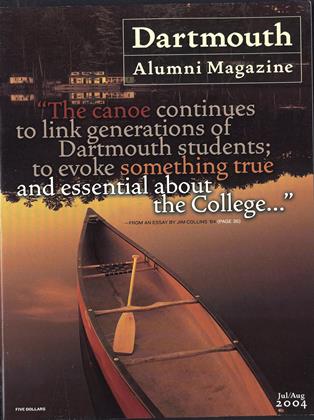A timeline of canoeing at Dartmouth
1690
Beaver pelts floated downriver in Montagnate canoes mark the opening of the North American fur trade—and set a precedent for long-distance tripping on the Connecticut River, The largest trading post on the river is located at Agawam, near present-day Springfield, Massachusetts,
1769
Eleazar Wheelock founds Dartmouth College. As recorded in A DartmouthChronicle, "Of all the colleges established in the Colonies prior to the Revolution, Dartmouth atone was situated in the wilderness. This fact perhaps more than any other has given to the College its unique character...."
1773
A flamboyant, debtridden dropout named John Ledyard, class of 1776, carves a canoe out of a 50-foot pine tree and floats away from Dartmouth, destined for Hartford, Connecticut, and a life of spectacularly unsuccessful adventure.
1858
Ralph Waldo Emerson is joined by elite members of the literati at his "Philosophers' Camp" in the Adirondacks, sparkinga tradition of fishing, shooting and canoeing among Eastern intellectuals and academies.
1872
Dartmouth students organize a crew, signaling the first official student recreational use of the Connecticut River.
1920
Students start a canoe club, which they name after the now-legendary Ledyard.
1920
Richard Goddard '20 and Evan Woodward '22 attempt a full-moon weekend trip down the Connecticut to Holyoke. In the dark, near Greenfield, Massachusetts, the pair misses a sharp turn and paddles partway up Miller's River—a mistake repeated by generations of Ledyard paddlers.
1921
Thirteen paddlers make the first "Down-River Trip" from Hanover to Long Island Sound. The club invites a Fox Films cinematographer along for the ride. Though two of the seven canoes fail to complete the journey, the resulting short-subject film is a national success.
1924
Ledyard Canoe Club extends summer memberships to women.
1930
With growing concern for river safety, the Ledyard Rescue Squad is formed. Members are called "The Body Snatchers."
1931
Club members smuggleCanadian-built Chestnutcanoes into the UnitedStates via Lake Champlain, avoiding customs. Three years later the practice halts when the raiding party is caught and forced to pay stiff fines.
1934
The "Trip to the Sea" is the last one for 20 years.
1940
Adventurous Dartmouth paddlers attempt to run Quechee Gorge. According to the off icial trip record, "All that remained of the expedition at its premature end was a foot of gunwale, some canvas, one paddle, and, fortunately, two canoeists."
1942
During an innocent overnight paddle to Northampton, Massachusetts, Howard Leavitt. Brad Copeland, and Chet from the class of 1943—are arrested and handcuffed in Windsor, Vermont, suspected of being Nazi spies.
1947
Dartmouth's "Woodsmen's Weekend" debuts at Storrs Pond, Events include one-and two-man canoe races.
1949
Ledyard Club membership climbs to 60. Canoe fleet grows to 22.
1955
Explorer Arthur Moffatt '41 leads three Dartmouth students and two others on a highly publicized 900-mile expedition through the Canadian barrens south of the Arctic Circle. Three hundred miles from the end, two of the three canoes capsize in heavy rapids. Moffatt dies of exposure.
1960
Life publishes a photo essay on "Dartmouth's Annual Down-River Trip."
Also, Pete Knight' 62 and Jon Fairbank '62 establish the modem, seemingly unassailable Trip to the Sea speed record of 33 hours, 50 minutes.
1964
A Dartmouth group led by Dan Dimancescu '64 and Bill Fitzhugh '64 paddles 1,685 miles down the Danube River through eight countries in 73 days. The rare glimpse behind the Iron Curtain results in a 45-page feature in NationalGeographic.
1968
A newspaper account records the first coed Trip to the Sea: "The annual 240-mile canoe trip by Dartmouth students down the Connecticut River was slowed by the presence of six females, but the six girls from Mount Holyoke made up for it with their cooking."
1975
Intrepid paddlers Chris Daniell '76, Dave Clement '73 and an incredulous exchange student from Smith rescue a deer from an ice floe in the Connecticut River. They revive the deer inside the Ledyard clubhouse.
1976
To help celebrate thenation's bicentennial, Dartmouth Outing Club members portage two aluminum canoes over the top of 6,288-fool Mount Washington,
1977
Bill Nutt '76 and Rocky Geyer '77 construct the Ledyard Club's legendary war canoe.
1988
The U.S. Canoe Association chooses Hanover to host its annual national championships.
1995
C Everett Koop '37 donates his yellow Old Town canoe to the Ledyard Canoe Club, with the request that the canoe be named "Sparky" in honor of his granddaughter.
2002
National canoeing championships, co-chaired by Peter Heed '72, return to Hanover.
2004
Ledyard Canoe Club inventory stands at 20 canoes, 42 kayaks, 12 sea kayaks and one war canoe recently restored.
Three Centuries of Water Over the Dam
 View Full Issue
View Full Issue
More From This Issue
-
 Cover Story
Cover StoryCanoes Undying
July | August 2004 By JIM COLLINS ’84 -
 Feature
FeatureShoot to Thrill
July | August 2004 By DAVID MCKAY WILSON -
 Feature
FeatureUnderstanding Failure
July | August 2004 By JULIE SLOANE ’99 -
 Feature
FeatureOn The Water
July | August 2004 By JIM COLLINS '84 -
 Faculty Opinion
Faculty OpinionTrade, Jobs and Politics
July | August 2004 By Douglas A. Irwin -
 Sports
SportsYouth at Risk
July | August 2004 By Irene M. Wielawski
Article
-
 Article
ArticleFIRST NEW HOCKEY RINK NOW WELL UNDER WAY
December 1920 -
 Article
ArticleAlumni College
April 1937 -
 Article
ArticleFaculty Articles
APRIL 1963 -
 Article
ArticleHealth Care
SEPTEMBER 1988 -
 Article
ArticleRank the Student Newspapers in Order of Their Interest to You
NOVEMBER 1991 -
 Article
ArticleTHE FACULTY
June 1962 By GEORGE O'CONNELL




